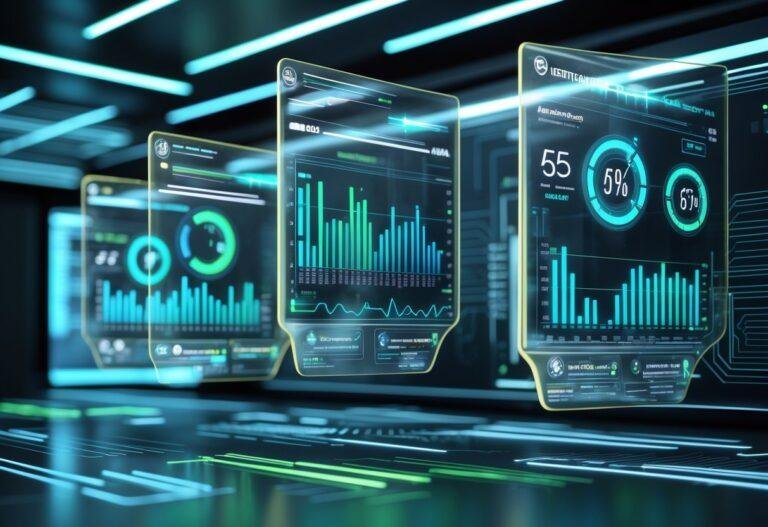Best Platforms for Automatic Text Data Decoding 2025: Top Tools & Features
Text data is everywhere these days. Customer reviews, social posts, survey answers, and support tickets pile up fast—honestly, it can feel overwhelming.
Businesses are hunting for smarter ways to turn all this unstructured text into something useful, and they need it done quickly.

The best AI-powered text analysis platforms in 2025—like Displayr, Amazon Comprehend, Azure AI Language, and Google Cloud Natural AI—each bring something different to the table for automatic text decoding.
They use machine learning and natural language processing to spot patterns, emotions, and themes in your data, so you don’t have to wade through it all yourself.
Which platform is right for you? It depends on what you need. Some shine with market research and surveys, while others are built for heavy-duty enterprise data or social media monitoring.
Think about your budget, your tech skills, and what kind of data you’re working with—those are big factors.
What You’ll Learn?
- Modern text decoding platforms use AI and machine learning to pull insights from unstructured text automatically
- Some platforms are better for market research, others for big enterprise data or social media
- Your best bet depends on your data volume, technical know-how, and what you’re trying to solve
Defining Automatic Text Data Decoding
Automatic text data decoding is all about turning raw text into structured insights with the help of AI.
This process mixes natural language processing and machine learning to pull out meaning, sentiment, and patterns from messy data, no manual effort needed.
What Is Automatic Text Data Decoding?
Imagine teaching computers to read and understand human language like we do. That’s basically what automatic text data decoding is.
The tech chews through huge amounts of text, picking out patterns, themes, and connections. No more reading and coding every survey response by hand.
Core functions include:
- Turning text into structured data
- Spotting key topics and themes
- Pulling out entities like names and locations
- Sorting content by subject
It breaks text into smaller bits, analyzes each for meaning, and then organizes everything into insights you can actually use.
The Role of Artificial Intelligence and NLP
AI is the engine here, with advanced algorithms doing the heavy lifting. Natural language processing (NLP) is what lets machines catch the subtleties of how we talk and write.
Modern text analysis tools use AI to deal with complex language, slang, and context that can trip up basic systems.
Key AI technologies involved:
- Machine learning for pattern spotting
- Deep learning for understanding meaning
- Neural networks for context
- Transformer models for language comprehension
NLP lets computers parse grammar, syntax, and meaning. It’s not just about words—it’s about connecting the dots and even picking up on tone or intent.
These AI models get smarter as they see more data, so their accuracy improves over time. That’s pretty cool, honestly.
Key Applications in 2025
You’ll see automatic text data decoding popping up everywhere in 2025. Survey responses and customer feedback are probably the most common spots.
Primary applications include:
| Application Area | Purpose | Benefits |
|---|---|---|
| Customer Feedback | Analyze reviews and complaints | Faster issue identification |
| Market Research | Process survey responses | Deeper consumer insights |
| Social Media | Monitor brand mentions | Real-time reputation tracking |
| Support Tickets | Categorize customer issues | Improved response times |
Companies use this tech to process customer service chats and emails automatically. You can spot trending issues or hot topics without digging through everything yourself.
Healthcare groups analyze patient feedback and records, while banks use it for loan applications and compliance docs.
It also helps with content moderation—flagging inappropriate stuff or spam so humans don’t have to babysit every message.
Key Features to Look for in Decoding Platforms

Picking a text data decoding platform? You’ll want to check out its accuracy, automation, integration options, and security. These things really shape how well the platform works for you.
Data Quality and Accuracy Considerations
Accuracy rates are the backbone here. Look for at least 95% accuracy for most text processing tasks—otherwise, what’s the point?
NLP platforms like Azure CLU and Google Dialogflow are known for great semantic understanding, even with a small amount of training data.
Error handling matters too. Good platforms flag low-confidence results so you can review them, instead of letting mistakes slip through.
It’s handy if your platform can handle multiple file types—PDFs, images, structured docs, you name it. That way, your data quality stays high no matter the input.
Real-time validation is a lifesaver. Platforms that check extracted info against your rules as they process save you a ton of cleanup time later.
Scalability and Workflow Automation
Processing volume is a biggie. If your data is growing, you need a platform that can keep up without slowing down.
Batch processing is another plus. Queue up a bunch of docs and let the platform crunch through them, maybe overnight—super efficient.
API rate limits can sneak up on you. Some NLP platforms like Wit.ai are more generous, but others have tight monthly caps.
Workflow automation features you’ll want:
- Auto-routing files based on type
- Triggering analysis when new files pop in
- Custom rules for different data
- Easy integration with your existing document systems
Load balancing is crucial if you’ve got peaks and valleys in your workload. Distributed processing means you don’t get bogged down when things get busy.
Integration Capabilities
API compatibility affects how smoothly your platform plugs into what you already use. REST APIs are usually the most flexible for custom builds.
Pre-built connectors can save you a lot of headaches. Look for platforms that already connect with Salesforce, Microsoft Office, Google Workspace, and so on.
Database connectivity is a must if you want automatic storage and retrieval. Make sure your platform supports the big names—MySQL, PostgreSQL, and cloud-based stuff.
Webhook support is great for real-time syncs between your systems. It’ll trigger actions in your other apps as soon as processing is done.
And if you’re thinking long-term, cloud compatibility with AWS, Azure, or Google Cloud gives you more flexibility down the road.
Data Security and Compliance
Encryption is non-negotiable. Go for AES-256 for data at rest and TLS 1.2 for data in transit—don’t settle for less.
Compliance certifications are a must if you’re in regulated industries. Healthcare needs HIPAA, while SOC 2 Type II is a solid general security badge.
Access control features to look for:
- Role-based permissions
- Multi-factor authentication
- Full audit trails
- Session timeouts
Data residency matters if you have to follow local privacy laws. Some platforms let you pick where your data lives, which is a big help.
Backup and recovery—you’ll want daily automated backups and the ability to roll back to a specific point if something goes sideways.
Top Platforms for Automatic Text Data Decoding in 2025
The world of text decoding platforms is changing fast, thanks to generative AI and advances in NLP. AI-powered text analysis tools are getting more powerful at pulling insights from messy data, no matter your industry.
Overview of Industry-Leading Solutions
Azure AI Language is Microsoft’s main text analysis platform. You get tools for named entity recognition, sentiment analysis, and key phrase extraction.
If you’re already using Microsoft’s cloud, integration is basically seamless. That’s a huge plus for a lot of teams.
Amazon Comprehend is built for enterprise-scale text processing. It’s great for analyzing huge volumes of unstructured text, thanks to its machine learning backbone.
Financial and legal teams really lean on Amazon Comprehend for classifying documents and pulling out entities. It’s especially good at finding links between complicated financial events.
Google Cloud Natural Language AI taps into Google’s machine learning chops. You get strong entity analysis and sentiment detection, and it works with different data formats.
One neat thing: it goes beyond just text. With speech-to-text, you can analyze audio as well as written docs.
Comparing Platform Capabilities
| Platform | Best For | Key Strengths | Integration |
|---|---|---|---|
| Azure AI Language | Enterprise Microsoft users | Multi-industry support, scalable | Seamless Microsoft ecosystem |
| Amazon Comprehend | Legal/Financial services | Large-scale processing, entity relationships | AWS infrastructure |
| Google Cloud Natural AI | Multi-format analysis | Speech-to-text, flexible NLP | Google Cloud services |
Processing power isn’t the same across the board. Azure AI is solid with multiple languages, while Amazon Comprehend is built for speed and volume.
Costs can swing a lot depending on how you use the platform. Google Cloud is usually cheaper for speech analysis, but Azure can be a better deal if you’re mainly working with documents.
Security is tight on all three. You’ll get encryption, compliance options, and data residency controls wherever you land.
Niche and Emerging Players
Nuance stands out with its multilingual text processing chops. You can dig into handwritten notes, audio clips, and images—plus the usual documents.
The platform builds out topic summaries and does sentiment analysis in several languages. That’s a big win for global teams trying to wrangle data from everywhere.
ChatGPT is an easy pick for basic text analysis if you just want to get started. Sentiment checks and entity recognition are as simple as tossing in a prompt.
Free and budget-friendly options make ChatGPT a good fit for smaller datasets or when you’re watching costs. The catch? Token limits mean it’s not built for huge jobs.
Generative AI platforms are shaking up how we decode text. These tools don’t just analyze—they actually generate content too.
Now you can summarize, sort, and pull insights while auto-generating reports. It seriously cuts down on the manual grind.
Advanced Machine Learning and NLP Techniques
These days, text decoding platforms lean hard on transformer models like BERT. They’re great at picking up context and relationships between words, even subtle stuff.
BERT (Bidirectional Encoder Representations from Transformers) changed the game by letting machines read in both directions at once. It helps your platform actually “get” the context, not just the words.
NLP tools have come a long way—deep learning models are the new normal. Big language models like GPT-4 and Claude can chew through millions of tokens in one go.
Why transformers are a big deal:
- They really get context
- Blazing fast processing
- Work across tons of languages
- Come with massive pre-trained knowledge
You can tweak these models for niche jobs like legal docs or medical records. That’s how you get the accuracy where you need it.
Most platforms now hand you API access, so you don’t need to be a machine learning wizard to use them.
Entity Recognition and Text Classification
Named entity recognition (NER) is all about spotting things like names, dates, places, and organizations in your text. It’s critical for turning messy documents into structured data.
Text classification, on the other hand, sorts stuff into buckets—emails, tickets, research papers—based on what’s inside.
Common entities you’ll see:
- Person names – John Smith, Maria Rodriguez
- Organizations – Microsoft, Harvard University
- Locations – New York, Europe
- Dates and times – January 15, 2025
- Monetary values – $1,000, €500
Machine learning models get better at this as you feed them more labeled examples. It’s a bit of a “practice makes perfect” situation.
Modern tools often mix and match classification methods, so you get better results for all kinds of documents.
Sentiment Analysis and Conversational AI
Sentiment analysis checks for tone—positive, negative, or just neutral. You can run it on customer feedback, social posts, or surveys and get a quick read on how people feel.
AI text analysis digs into patterns, intent, and even subtle emotions across piles of unstructured text. The best systems can spot things like frustration or excitement, not just happy or sad.
Conversational AI takes it further, powering chatbots and assistants that actually understand what you want and respond in kind.
How sentiment gets scored:
- Lexicon-based – Relies on word lists
- Machine learning – Learns from real examples
- Hybrid – Mixes both techniques
With strong conversational AI, your bots can keep up with longer chats and remember previous messages. That’s how you get a more natural back-and-forth, no matter the channel.
Specialized Use Cases and Integrations

Different industries have their own weird needs when it comes to text decoding. Platforms now offer focused tools for stuff like visual data extraction, business intelligence, or conversational AI.
Image Processing and OCR Solutions
Text decoding tools now blend OCR with advanced image processing. That means you can pull text out of scans, photos, and even tricky layouts.
OCR heavyweights like Google Cloud Vision API and Amazon Textract handle handwritten notes, multiple languages, and even not-so-great images.
What to look for in OCR:
- Batch processing (for lots of files)
- Handles different file types
- Confidence scores so you know what’s accurate
- Can read tables and forms
Some platforms go deep on specific docs. Invoices? There are tools for that. Medical stuff? Yep, those exist too.
Want seamless workflows? Integration with data integration platforms lets you send OCR results straight to your databases or analytics stack.
Market Research and Analytics
Text analytics platforms are your friend for decoding customer feedback and market chatter. Surveys, social posts, reviews—they’ll crunch it all.
Sentiment tools flag the mood, while topic modeling shines a light on what everyone’s talking about.
Advanced platforms usually offer:
- Live social media tracking
- Competitor monitoring
- Custom categories
- Trend spotting
AI text analysis tools now spit out insights and recommendations for you. No more reading everything by hand.
Some tools are industry-specific. Retail platforms dig into product reviews, while healthcare tools focus on patient surveys.
Chatbots and Digital Assistants
Today’s chatbots use advanced text decoding to actually get what users mean. You can build bots that handle tricky questions and jump between topics without getting lost.
Natural language understanding (NLU) engines break messages down into usable data—entities, intent, even emotions.
Top platforms like Dialogflow, Microsoft Bot Framework, and Amazon Lex offer ready-to-go models for common scenarios.
Must-have chatbot features:
- Handles multi-turn conversations
- Picks out and checks entities
- Hooks into your business systems
- Tracks performance with analytics
You can connect bots to your existing support tools. Most of them play nice with CRM and ticketing systems.
Add voice? No problem—voice assistants bring speech-to-text so users can just talk to their devices.
Choosing the Right Platform for Your Organization
Picking the right text decoding platform really comes down to what your business needs, your workflow, and—let’s be honest—your budget. Integration, costs, and new tech trends all play a part.
Assessing Business Needs and Workflows
How much data you handle is a big deal. If you’re under 10,000 docs a month, basic cloud tools work fine. Got 50,000+? You’ll want something beefier, maybe enterprise-grade.
Data Types Matter Most
Different platforms are better at certain things:
- Handwritten stuff: Needs specialized OCR
- Structured forms: Template-based tools help
- Multi-language: Robust language detection is a must
- Bad scans: Advanced image cleanup required
Integration can make or break your rollout. Make sure your platform connects to your CRM, ERP, or doc management. APIs are huge for custom workflows and automation.
Security is all over the map depending on your field. Healthcare? Think HIPAA. Finance? SOX. Government? FedRAMP. It’s a lot to keep straight.
Speed matters too. Real-time decoding helps support teams, while batch processing is fine for monthly reports. Pick based on how fast you need answers.
Evaluating Costs and Support
Pricing models can sneak up on you. Per-document is good if your volume jumps around. Subscriptions work for steady usage. Big companies might save with enterprise licenses.
Hidden Costs to Watch For
- Setup and training fees
- Extra API calls
- Premium support
- Custom integrations
- More user licenses
Support can make or break your project. Look for 24/7 help, a dedicated account manager, and solid docs. Fast response times are a lifesaver if things go sideways.
Training is key for getting your team up to speed. Platforms with good tutorials and certifications make onboarding way easier. Videos and demos are a bonus.
Most platforms offer free trials—usually 14-30 days, with some usage caps. Use that time to run your real documents and see how things stack up.
Future Trends in Automatic Text Data Decoding
AI keeps getting better at reading text. These days, most platforms hit 95%+ accuracy with printed stuff and around 85%+ for handwriting.
Machine learning models start to pick up on your document quirks as you use them more. That’s pretty handy if your files aren’t exactly standard.
Edge computing is helping a lot with speed and privacy. Processing data locally means your sensitive info doesn’t have to leave your network.
Some setups mix local and cloud processing. That way, you get cloud power without giving up on-premise security.
Emerging Technologies
- Computer vision: Sharper image cleanup
- Natural language processing: More context awareness
- Blockchain: Clear audit trails for document handling
- Quantum computing: Wildly faster crunching for tough files (well, someday)
Mobile is a must now, especially for remote teams. With the right app, you can snap a pic and process a document right there—no scanner needed.
Data management platforms are starting to bake in text decoding, too. It’s nice not having to juggle so many different tools just to get your data sorted.
Compliance tools are popping up everywhere. GDPR, CCPA, niche rules—you name it, platforms are building in ways to help you stay out of trouble and cut down on paperwork.
Frequently Asked Questions
Traditional methods rely on manual tagging or keyword-based searches, while automatic text data decoding uses AI and NLP to understand language context, emotion, and meaning—making it faster and more accurate.
Absolutely. Many cloud-based tools like ChatGPT and Displayr offer affordable, scalable plans for startups and small teams that want insights without heavy technical setup.
Not always. Most modern tools now offer no-code dashboards, drag-and-drop interfaces, and pre-trained models that make setup simple—even for non-technical users.
Advanced NLP models like BERT and GPT handle multilingual text and slang using contextual understanding. They learn from vast datasets, so they can adapt to local expressions and tone better than older systems.
Text decoding converts unstructured data into structured insights, while sentiment analysis focuses specifically on emotional tone—positive, negative, or neutral—within the text.
Top providers like Azure, Google Cloud, and Amazon Comprehend use strong encryption (AES-256, TLS 1.2) and compliance standards such as SOC 2, GDPR, and HIPAA for maximum protection.
Yes. Most platforms include API integrations and connectors for tools like Salesforce, Excel, Google Workspace, and project management systems.
Modern systems handle scanned documents, PDFs, social media posts, emails, chat logs, and even audio converted via speech-to-text models.
They use machine learning feedback loops—each time they process and validate data, they refine their understanding of patterns, increasing future accuracy automatically.
Yes. Tools like SpaCy, NLTK, and Hugging Face models offer open-source frameworks. They’re great for developers who want to experiment without subscription fees.
Top adopters include healthcare, finance, e-commerce, and marketing—any field dealing with massive volumes of unstructured feedback or documents.
If data privacy is a top concern (e.g., healthcare or banking), go for on-premise. For flexibility and scalability, cloud-based platforms are usually the better choice.
Yes. Many platforms use AI classifiers to identify unnatural patterns, repetitive text, and sentiment inconsistencies typical of spam or fake feedback.
For cloud tools, insights can appear in minutes or hours. Enterprise setups may take a few weeks to train models for specific data types.
Expect deeper integration with generative AI, real-time emotion tracking, and multimodal analysis—combining text, voice, and visuals for richer insights.

